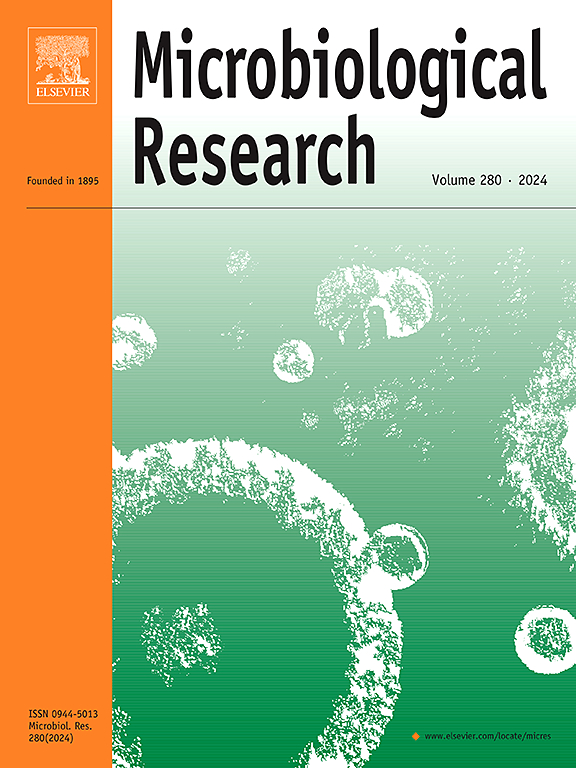Use in a controlled environment of Trichoderma asperellum ICC012 and Trichoderma gamsii ICC080 to manage FHB on common wheat
IF 6.1
1区 生物学
Q1 MICROBIOLOGY
引用次数: 0
Abstract
Fusarium head blight (FHB) represents a significant threat for wheat production due to the risk for food security and safety. Despite the huge number of biofungicides on the market, only one is actually available at European level to control Fusarium infections on cereals. The present work aimed to assess the possible use of Trichoderma asperellum strain ICC012 and Trichoderma gamsii strain ICC080 to manage FHB on common wheat Triticum aestivum cv Apogee. Initially, the capability of ICC012 and ICC080 to endophytically colonize wheat roots, a prerequisite very often correlated with the induction of resistance in the host plant, was investigated. It resulted in 100 % of roots internally colonized by the two strains, followed by a significant up-regulation of the defense-related genes encoding for pathogenesis-related protein 1 (pr1), superoxide dismutase (sod), polygalacturonase inhibitor protein 2 (pgip2) and phenylalanine ammonia-lyase 1 (pal1). When the expression of the same genes was investigated in spikes treated at the flowering stage with the two strains, applied individually or co-inoculated, a significant up-regulation of only pal1 was registered 24 hours post inoculation (hpi) in spikes treated with ICC080. To check if a systemic defense response was induced, the expression of the same genes was analyzed in leaves collected 7 and 14 days post inoculation (dpi) of roots, resulting in a significant up-regulation of sod at 7 dpi in leaves collected from plants inoculated with ICC012. Even if induction of resistance is probably not the main mode of action of the two strains, ICC012 and ICC080 applied on spikes at anthesis significantly reduced, in greenhouse conditions, the Disease Incidence (DI) caused by the inoculation mix of F. graminearum, F. culmorum, F. langsethiae and F. sporotrichioides, four of the most important FHB casual agents. This reduction in disease symptoms was observed when the two beneficial strains were applied both individually and co-inoculated on the spikes. Finally, ICC012 and ICC080 demonstrated a good competitive ability for substrate possession. The amount of F. graminearum (as DNA and number of perithecia) on wheat straw pieces was significantly reduced after 6 months of incubation in presence of the two beneficial strains, applied individually and co-inoculated. Being cultural debris used to overwinter, this competitive behavior of ICC012 and ICC080 is an important trait to reduce the potential inoculum of the pathogen. The results collected here lay the groundwork for the use of ICC012 and ICC080 in managing FHB on common wheat.
在受控环境中使用Trichoderma asperellum ICC012和Trichoderma gamsii ICC080防治普通小麦上的FHB病害
镰刀菌头疫病(FHB)对小麦生产构成重大威胁,因为它会危及粮食安全和食品安全。尽管市场上有大量的生物杀菌剂,但在欧洲范围内,实际上只有一种生物杀菌剂可用于控制镰刀菌对谷物的感染。目前的工作旨在评估是否可能使用赤霉菌(Trichoderma asperellum)菌株 ICC012 和γ-赤霉菌(Trichoderma gamsii)菌株 ICC080 来控制普通小麦 Triticum aestivum cv Apogee 上的镰刀菌。首先,研究了 ICC012 和 ICC080 在小麦根部内生定殖的能力,这是诱导寄主植物产生抗性的先决条件。结果发现,100% 的根系都被这两种菌株内定殖,随后编码病原相关蛋白 1 (pr1)、超氧化物歧化酶 (sod)、聚半乳糖醛酸酶抑制蛋白 2 (pgip2) 和苯丙氨酸氨化酶 1 (pal1) 的防御相关基因显著上调。在花期用这两种菌株单独或共同接种处理穗状花序时,对相同基因的表达情况进行了调查,结果发现,在接种后 24 小时(hpi),用 ICC080 处理的穗状花序中,只有 pal1 有显著的上调。为了检测是否诱导了系统性防御反应,对根部接种后 7 天和 14 天(dpi)收集的叶片中相同基因的表达进行了分析,结果显示,在接种 ICC012 的植株上收集的叶片中,sod 在接种后 7 dpi 有明显上调。尽管诱导抗性可能不是这两种菌株的主要作用方式,但在温室条件下,在花期将 ICC012 和 ICC080 施用于穗上,可显著降低由禾谷镰孢菌、高秆禾谷镰孢菌、兰氏禾谷镰孢菌和孢子禾谷镰孢菌(F. sporotrichioides)这四种最重要的 FHB 致病菌混合接种引起的病害发生率(DI)。当这两种有益菌株单独或共同接种在穗上时,病害症状都会减轻。最后,ICC012 和 ICC080 在底物占有方面表现出良好的竞争能力。在两种有益菌株单独接种和共同接种的情况下,经过 6 个月的培养,小麦秸秆碎片上的禾谷镰孢数量(以 DNA 和栖孢数量表示)明显减少。ICC012 和 ICC080 是用于越冬的文化碎片,它们的这种竞争行为是减少病原体潜在接种量的重要特征。本文收集的结果为使用 ICC012 和 ICC080 防治普通小麦上的 FHB 奠定了基础。
本文章由计算机程序翻译,如有差异,请以英文原文为准。
求助全文
约1分钟内获得全文
求助全文
来源期刊

Microbiological research
生物-微生物学
CiteScore
10.90
自引率
6.00%
发文量
249
审稿时长
29 days
期刊介绍:
Microbiological Research is devoted to publishing reports on prokaryotic and eukaryotic microorganisms such as yeasts, fungi, bacteria, archaea, and protozoa. Research on interactions between pathogenic microorganisms and their environment or hosts are also covered.
 求助内容:
求助内容: 应助结果提醒方式:
应助结果提醒方式:


